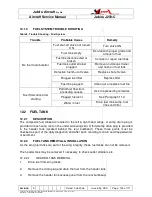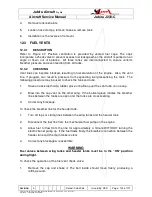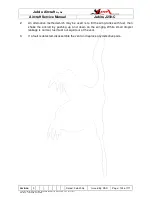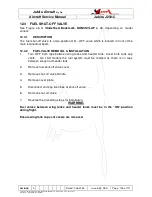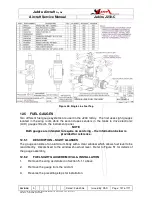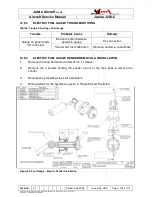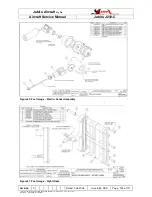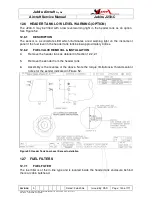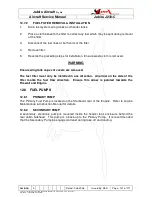
Jabiru Aircraft
Pty Ptd
Aircraft Service Manual
Jabiru J230-C
REVISION
0
Dated : Feb 2006
Issued By: RAS
Page: 136 of 171
L:\files\Technical_manuals\J230_J430\J230.J430_Work_files\J230-C_Tech_Rev_1.doc
Print Date: 14/01/2009 4:41:00 PM
2.
Use suitable fittings to connect lines together so that the altimeter is the only
instrument still connected into the static pressure system.
3.
Repeat leakage test to check whether static pressure system or the bypassed
instruments are the cause of the leakage. If instruments are at fault, they must be
repaired by an “appropriately authorised repair station”, or replaced. If static
pressure system is at fault, use the following procedure to locate the leakage.
4.
Attach a source of positive pressure to the static source opening. Figure 58 shows
one method of obtaining positive pressure.
CAUTION
Do not apply positive pressure with airspeed indicator or vertical speed indicator
connected to the static pressure system.
5.
Slowly apply positive pressure until altimeter indicates a 500-foot decrease in
altitude and maintain this altimeter indication while checking for leaks. Coat line
connectors and static course flange with solution of mild soap and water, watching
for bubbles to locate leaks.
6.
Tighten leaking connections. Repair or replace parts found to be defective.
7.
Reconnect airspeed and vertical speed indicators into static pressure systems and
repeat leakage test steps 3 through 6.
13.3.3
PITOT SYSTEM INSPECTION & LEAKAGE TEST
To check pitot system for leaks, place a piece of rubber or plastic tubing over pitot tube,
close opposite end of tubing and slowly roll up tube until airspeed indicator registers in the
cruise range. Secure tube and after a few minutes recheck airspeed indicator. Any
leakage will have reduced the pressure in the system, resulting in a lower airspeed
indication. Slowly unroll tubing before removing it, so pressure may be released gradually.
Otherwise instrument may be damaged. If the test reveals a leak in the system, check all
connections for tightness.
13.3.4
BLOWING OUT LINES
Condensation may collect at points in the pitot system and produce a partial obstruction.
To clear line, disconnect airspeed indicator. Using low pressure air, blow from indicator
end of line toward pitot tube.
CAUTION
Never blow through pitot or static lines towards the instruments.
Like pitot lines, static lines may be kept clear and connections tight. When necessary,
disconnect static line at first instrument to which it is connected, then blow line clear with
low pressure air. Check all static pressure lines for tightness. If hose or hose connections
are used, check for general condition and clamps for security. Replace hose which has
cracked, hardened or shows signs of deterioration.

